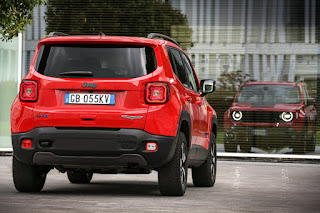UK prices for the hybrid Jeep Renegade 4xe
Jeep will soon join the ranks of manufacturers marketing electrified models in the UK. The Renegade 4xe – a plug-in hybrid – is due to arrive at dealers in September.
Its powertrain is fairly complex.
Driving the front axle is an electric motor-generator, plus a 1.3 litre, four-cylinder, turbocharged petrol engine that’s mated to a six-speed automatic transmission. On Longitude and Limited grades this set-up produces 128 bhp (95 kW / 130 PS) and 270 Nm (199 lb-ft) of torque, but the Trailhawk boasts 177 bhp (132 kW / 180 PS).
In addition, all versions have a separate electric motor for the rear axle which delivers 59 bhp (44 kW / 60 PS) with 250 Nm (184 lb-ft). Beneath the second row of seats, encased in protective steel, is a 11.4 kWh lithium-ion battery pack. Recharging at home takes less than five hours via a dedicated 2.3 kW easyWallbox, or less than two hours if the optional 7.4 kW upgrade is ordered instead.
As there’s no mechanical prop shaft, such an arrangement means torque split between the axles can be allocated more precisely. Consequently, grip is the claimed beneficiary, especially when tackling rough terrain.
Also integral to the Jeep’s off-road ability is Active Drive Low. Fitted as standard, it combines two elements.
Firstly, Selec-Terrain traction control incorporates Hill Descent Control and a choice of ‘Auto’, ‘Sport’, ‘Sand/Mud’, ‘Snow’ and – only on the Trailhawk – ‘Rock’ settings.
Secondly, the eAWD system offers a choice of ‘4WD Lock’ and ‘4WD Low’ configurations. The former permanently engages four-wheel drive up to 9 mph (15 km/h), with an on-demand service kicking in at higher speeds. Crucially, the state of the battery doesn’t affect anything, as a ‘Powerlooping’ function ensures that the front motor-generator instantaneously sends current to the rear motor if required.
Clearly, Renegade 4xe users are going to have to enjoy making decisions, because one of three driving modes must be selected too.
In ‘Hybrid’ (the default), the petrol engine and electric motors work together. As well as a 0-62 mph (100 km/h) time of around 7.5 seconds and a 124 mph (200 km/h) top speed, up to 134 mpg (2.1 l/100km) is possible while emitting less than 50 g/km of CO2.
Unsurprisingly, switching to ‘Electric’ turns off the combustion engine. Maximum range is a modest 26 miles (42 kilometres) though, and top speed gets restricted to 81 mph (130 km/h) to help conserve energy.
Completing the trio is ‘E-Save’. Essentially, its role is to maintain or top-up the battery’s charge through deployment of the motor-generator.
On-the-road prices start at:
Related posts:
Jeep Wrangler Rubicon 392 Concept unveiled
2019 Jeep Renegade first view
Its powertrain is fairly complex.
Driving the front axle is an electric motor-generator, plus a 1.3 litre, four-cylinder, turbocharged petrol engine that’s mated to a six-speed automatic transmission. On Longitude and Limited grades this set-up produces 128 bhp (95 kW / 130 PS) and 270 Nm (199 lb-ft) of torque, but the Trailhawk boasts 177 bhp (132 kW / 180 PS).
In addition, all versions have a separate electric motor for the rear axle which delivers 59 bhp (44 kW / 60 PS) with 250 Nm (184 lb-ft). Beneath the second row of seats, encased in protective steel, is a 11.4 kWh lithium-ion battery pack. Recharging at home takes less than five hours via a dedicated 2.3 kW easyWallbox, or less than two hours if the optional 7.4 kW upgrade is ordered instead.
As there’s no mechanical prop shaft, such an arrangement means torque split between the axles can be allocated more precisely. Consequently, grip is the claimed beneficiary, especially when tackling rough terrain.
Also integral to the Jeep’s off-road ability is Active Drive Low. Fitted as standard, it combines two elements.
Firstly, Selec-Terrain traction control incorporates Hill Descent Control and a choice of ‘Auto’, ‘Sport’, ‘Sand/Mud’, ‘Snow’ and – only on the Trailhawk – ‘Rock’ settings.
Secondly, the eAWD system offers a choice of ‘4WD Lock’ and ‘4WD Low’ configurations. The former permanently engages four-wheel drive up to 9 mph (15 km/h), with an on-demand service kicking in at higher speeds. Crucially, the state of the battery doesn’t affect anything, as a ‘Powerlooping’ function ensures that the front motor-generator instantaneously sends current to the rear motor if required.
Clearly, Renegade 4xe users are going to have to enjoy making decisions, because one of three driving modes must be selected too.
In ‘Hybrid’ (the default), the petrol engine and electric motors work together. As well as a 0-62 mph (100 km/h) time of around 7.5 seconds and a 124 mph (200 km/h) top speed, up to 134 mpg (2.1 l/100km) is possible while emitting less than 50 g/km of CO2.
Unsurprisingly, switching to ‘Electric’ turns off the combustion engine. Maximum range is a modest 26 miles (42 kilometres) though, and top speed gets restricted to 81 mph (130 km/h) to help conserve energy.
Completing the trio is ‘E-Save’. Essentially, its role is to maintain or top-up the battery’s charge through deployment of the motor-generator.
On-the-road prices start at:
- Renegade 4xe Longitude – £32,600
- Renegade 4xe Limited – £34,500
- Renegade 4xe Trailhawk – £36,500
Related posts:
Jeep Wrangler Rubicon 392 Concept unveiled
2019 Jeep Renegade first view





%2BDashboard.jpg)

+Front+Side.jpg)

+Front+Side.jpg)

Comments
Post a Comment